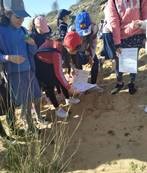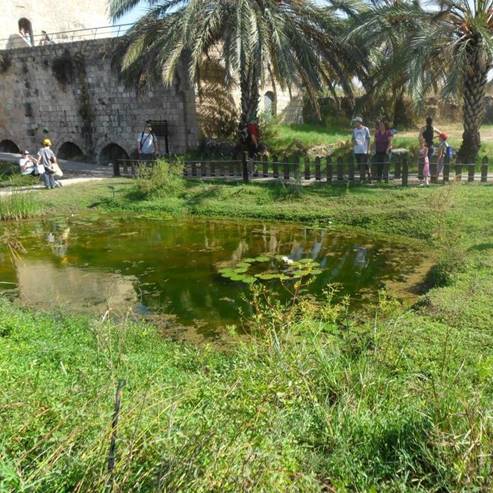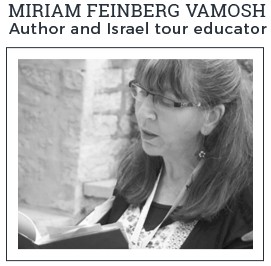Common Ground
Common Ground
Proverbs 22:6 said it first: “Train up a child in the way he should go, and when he is old he will not depart from it.” The Israel Nature and Parks Authority and the Israel Nature and Heritage Foundation are doing exactly that: They’re quietly going about the business of inculcating love of the land while fostering ties among children of all ethnic and religious communities.

In Israel, this is no easy task. Jewish and Arab children have their own separate school systems (and further divisions within those communities). They follow their own curricula, and with few notable exceptions* (see “Want to Know More” below) the language of study is either Hebrew or Arabic depending on the student body. The idea at the time was that considering the complex human mosaic in Israel, the language, heritage, faith and even the political affiliations of a child’s community should be a mainstay of his/her education. As a result, there are few opportunities for Jewish and Arab children to get to know each other; some don’t meet “the other” until they reach adulthood. And yet, the many dozens of groups in Israel devoted to intercultural and interfaith dialogue in Israel show the hunger for precisely this kind of interaction.
The Israel Nature and Parks Authority, with the assistance of the Israel Nature and Heritage Foundation, is an important part of this work: They offer programs for children get to know Israel’s treasures of nature, landscape and heritage right in the vicinity of their homes – while they get to know children from other cultures by bringing together schools of both ethnicities.
The program consists of a series of meetings with Israel Nature and Parks Authority instructors throughout the year, some in and around the school and some in national parks and nature reserves near home. Homeroom teachers work closely with the INPA in the process to make sure the program gets the time and space it needs in the children’s school life. In addition to field trips, students take part in outdoor work that contributes to their environment, for example, uprooting invasive species, marking trails and banding birds.

Over the years, the program has fostered a positive relationship to nature among schoolchildren, which has made them more aware and involved in the conservation of nature, landscape and heritage in Israel. Best of all, perhaps, is that the program reaches beyond classrooms and field trips into the community: End-of-the-year events see participants in the program guiding their peers, and parents are hosted and treated to exhibits and information booths where their kids can share their new-found knowledge.
This land is your land, this land is my land…in Bible times
En Afek Nature Reserve is one of the sites where the coexistence program has been in full swing for many years. But we might even say – though granted, it’s a bit of a stretch – that at biblical Afek economic coexistence goes back some 3,000 years. That’s if we recall the story of Solomon rewarding King Hiram of Tyre, north of Afek, with 20 cities in the region, apparently Afek among them, in exchange for cedar trees and gold to build the Temple in Jerusalem (1 Kings 9:11-13). (Well, if you delve into the story, you’ll discover contention with our neighbors is also nothing new.)
But back to thinking positive: The program at the En Afek Nature Reserve brings together students from Arabic- and Hebrew-speaking elementary schools from the surrounding communities. The principle is the realization that despite the language barrier at this age, encounters among younger children are essential to try to “catch” them before cultural and religious prejudices take root. The En Afek Nature Reserve has it all – flora and fauna, a spring, a pond, heritage, shared history – making it a wonderful tool to create a direct connection among the young visitors from different backgrounds and among their teachers. Each program involves one Arabic-speaking class and one Hebrew-speaking class. Two preparatory meetings are held in the classroom and on school grounds in each school, in the children’s mother tongue. Two more meetings are field trips at the En Afek Nature Reserve including a tour of the reserve and interactive social activities to create cohesion. Instructors choose hands-on, fun activities where verbal communication is less needed, and that helps the kids overcome language barriers. Groups are manageably small, with 15 kids per instuctor. Each field trip features a visit to a different part of the reserve or a different main subject (for example, the archaeological mound, the pond habitat, the ancient flour mill and birdwatching).

In the two final meetings, each group hosts the other in their school. During these meetings the children get to know each other’s culture. These meetings are led by the homeroom teachers together with the students in cooperation with the INPA instructors. Parents are often invited to the closing day to see what their kids have accomplished and spread the word about coexistence and nature protection throughout the community.
The program at En Afek Nature Reserve is one of some 25 such programs being held throughout Israel. After a year’s interruption due to the coronavirus pandemic school closures, everyone is looking forward to the fall and the renewal of this all-important work.

Want to know more?
“Children of Israel, Together for Nature.” https://inhfa.org/eco-existence/
“Education across the divide: Shared learning of separate Jewish and Arab schools in a mixed city in Israel” https://journals.sagepub.com/doi/abs/10.1177/1746197917698489?journalCode=esja
*Joint Jewish-Arab Hand-in-Hand schools: https://handinhandk12.org

